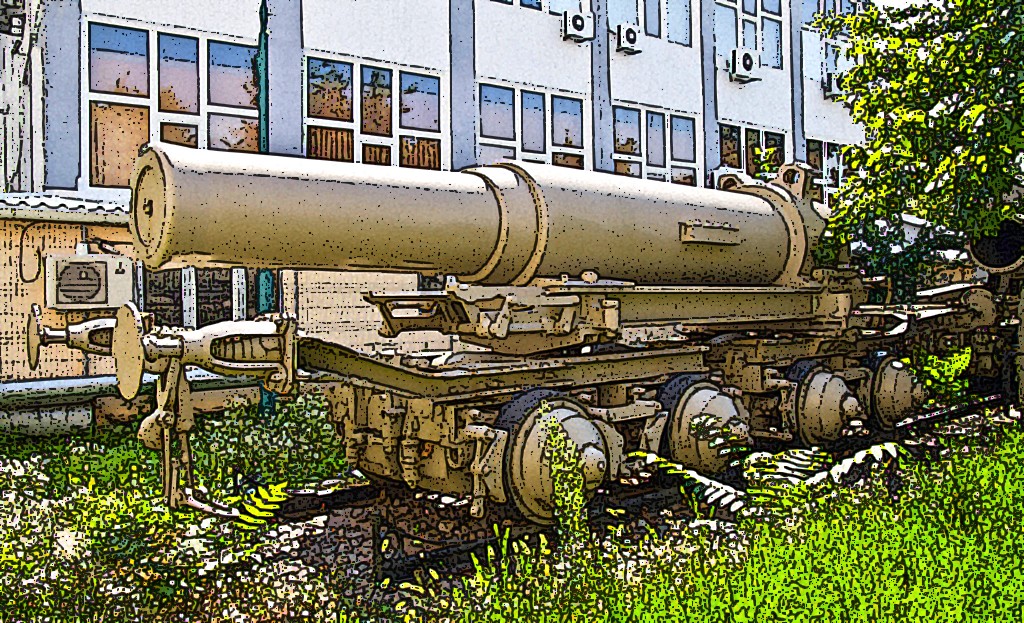


38 cm Belagerungshaubitze M 16 Vienne
English Translation
Merci à Vincent pour ces photographies
 |
Historique Voir ICI
History Click HERE
Histoire de ce canon (traduction )
Au printemps 1915, Karl Freiherr von Skoda, directeur de la célèbre usine de Pilsen, a été autorisé à visiter les forteresses belges qui avaient été écrasées par l'artillerie lourde allemande aidée par l'artillerie Austro-hongroise avec ses 30,5 cm M11 pendant l'été 1914.
Impressionné, il a rapidement demandé à ses ingénieurs de travailler sur un nouvel obusier avec un calibre aussi grand que possible et ayant une portée d'au moins 15 km, tout en restant aussi mobile que les mortiers M11.
La conception a été très rapide et a permis à Skoda de proposer spontanément à l'armée austro-hongroise un obusier de 38 cm de 17 calibres dès le mois de mai 1915, ainsi qu'un autre obusier de 24 cm de 40 calibres en novembre 1915. La commande pour deux obusiers de 38 cm est passée en Juillet 1915. Les deux premières canons, nommées «Barbara» et «Gudrun», sont testées entre janvier et avril 1916, puis utilisées avec succès sur le front italien lors de l'offensive printanière qui a débuté le 15 mai 1916 près de Rovereto. Les excellentes propriétés balistiques démontrées lors de ce véritable test ont décidé l' Etat Major de commandert 14 autres canons de ce type.
L'obusier 38 cm H M16 s'inspire des modèles allemands et austro-hongrois de 30,5 cm et 42 cm, mais il comprend plusieurs innovations, notamment un système de culasse simplifié et une mobilité particulièrement bien conçue. Pour atteindre cet objectif, ce géant de 80 tonnes a été divisé en 4 fardeaux distincts, transportés chacun par un train routier composé de wagons spéciaux équipés de 8 roues motorisées (ayant chacun leur propre moteur électrique), couplé à un wagon possèdant une génératrice fournissant Énergie à la fois pour le wagon et pour elle-même. Les roues de ces wagons pourraient être enlevées afin que le convoi puisse utiliser les chemins de fer pour le transport sur de longue distance.
Les obusiers qui furent consrtuits par la suite ont reçu de nombreuses améliorations, dont la la plus visible étant une variante du chariot ayant deux paires de positions de tourillons, ce qui permet de l'utiliser soit pour l'obusier M16 de 38cm ou le canon M16 de 24cm (qui fut moins réussi et construit seulement en 9 exemplaires
. Un total de 11 obusiers de 38 cm ont été construits avant la fin de la guerre. Ils étaient engagés sur le front oriental et dans les Alpes, mais aussi sur le front Ouest (à St Quentin).
Étrangement, les obusiers survivants de 38cm n'ont pas été utilisés par le Wermacht allemand pendant WW2.
Les canons lourds ont été capturés à l intérieur de l'usine Skoda à Györ, en Hongrie,en 1919 durant l'intervention roumaine en Hongrie contre le nouveau gouvernement communiste . Durant cette intervention cautionnée par les puissance alliées dont la France, representée localement par le General Bertthelot l'Armée roumaine s'est ainsi emaprée de nombres de canons lourds Skoda .
In spring 1915, Karl Freiherr von Skoda, director of the famous Pilsen factory, was allowed to visit the Belgian fortresses that had been crushed by the German heavy artillery assisted by the Austro-Hungarian 30.5cm M11 during summer 1914. Impressed, he quickly commanded his engineers to work on a new howitzer with a caliber as big as possible and with a range of at least 15 km, while staying as mobile as the M11 mortars.
The design was real quick and allowed Skoda to propose spontaneously to the Austro-Hungarian army a 17 calibres 38cm howitzer as soon as May 1915, as well as a 40 calibres 24cm heavy gun in November 1915. An order for two 38cm howitzers was given in July 1915. The two first weapons, named 'Barbara' and 'Gudrun' were tested between January and April 1916, and then used successfully on the Italian front during the spring offensive that started on May 15 1916 near Rovereto. The excellent ballistic properties demonstrated during this real fight test decided the army to order 14 other such weapons.
The '38cm H M16' howitzer was inspired by its famous German and Austro-Hungarian 30.5cm and 42cm ancestors, and included several innovations, including a simplified breech system and a particularly well designed movability. In order to achieve this target, this 80 tons giant was divided into 4 separate loads, each transported by a road train composed of special wagons equipped with 8 motorized wheels (having each their own electric motor), coupled with a generator truck that was providing energy both for the wagon and itself. The wheels of these wagons could be removed so that the convoy could use the railways for long distance transport.
The howitzers that followed the first two ones received numerous improvements, the most visible of which being a variant of the massive carriage, this time having two pairs of trunnions positions, allowing it to be used either for the 38cm M16 howitzer or the 24cm M16 gun (that was less succesful and built in 9 items).
. A total of 11 such 38cm howitzers were built before the end of the war. They were engaged on the Eastern front and in the Alps, but also on the West front (at St Quentin). Strangely, the surviving 38cm howitzers were not used by the German Wermacht during WW2.
This impressives howitzer were been captured inside a Skoda plant in Györ, Hungaria, in 1919 during the Rumania intervention in Hungaria to throw the new communist government away. During this intervention cautioned by the allied governments (including France, locally represented by the General Bertthelot mission), the Rumanian army seized several Skoda very heavy artillery guns.